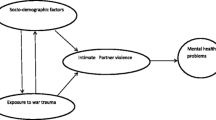Abstract
Intimate partner violence (IPV) is classified into physical, sexual, emotional, and psychological types. The aim of this study is to determine the complications of IPV in Iran. A case control study was done on women referred to the forensic medicine center with a complaint of IPV as cases, and women referred to the urban health centers for routine care as control group. The most common physical complication was hematoma in 99 and 33 % of cases and controls respectively. Among chronic complaints, headache was the most frequent among 64 and 19 % of case and control groups respectively. Depression and anxiety were the most common mental complications. The effects of IPV are serious problems and should be considered in counseling.
Similar content being viewed by others
References
Abadi, M. N., Ghazinour, M., Nygren, L., Nojomi, M., & Richter, J. (2013). Birth weight, domestic violence, coping, social support, and mental health of young Iranian mothers in Tehran. Journal of Nervous and Mental Disease, 201, 602–608. doi:10.1097/NMD.0b013e3182982b1d.
Ambling, M. (2000). The effect of clinical supervision on the development of counsellor competency. Psychotherapy in Australia, 6, 58–63.
Bonomi, A. E., Thompson, R. S., Anderson, M., Reid, R. J., Carrell, D., Dimer, J. A., & Rivara, F. P. (2006). Intimate partner violence and women’s physical, mental, and social functioning. American Journal of Preventive Medicine, 30, 458–466. doi:10.1016/j.amepre.2006.01.015.
Campbell, J. C. (2002). Health consequences of intimate partner violence. The Lancet, 359, 1331–1336. doi:10.1016/S0140-6736(02)08336-8.
Coker, A. L., Davis, K. E., Arias, I., Desai, S., Sanderson, M., Brandt, H. M., & Smith, P. H. (2002). Physical and mental health effects of intimate partner violence for men and women. American Journal of Preventive Medicine, 23, 260–268.
Gahhari, S., Mazdarani, S., Khalilian, A. R., & Zarghami, M. (2008). Spouse abuse in Sari-Iran. Iranian Journal of Psychiatry and Behavioral Sciences, 2, 31–35.
Garcia-Moreno, C.A.F.M.H., Ellsberg, M., Heise, L., & Watts, C. (2005). WHO multi-country study on women’s health and domestic violence against women, initial results on prevalence, health outcomes and women’s responses, WHO Library Cataloguing-in-Publication Data, World Health Organization, 15–95.
Ghazi Tabatabai, M., Mohsen Tabrizi, A. R., & Marjai, S. H. (2004). Studies on domestic violence against women (in Persian). Tehran: Office of Public Affairs, Ministry of Interior, Center of Women and Family Affairs of the Presidency of the Islamic Republic of Iran.
Hassan, M., Kashanian, M., Hassan, M., Roohi, M., & Yousefi, H. (2014). Maternal outcomes of intimate partner violence during pregnancy: study in Iran. Public Health. doi:10.1016/j.puhe.2013.11.007.
Jayatilleke, A. C., Poudel, K. C., Yasuoka, J., Jayatilleke, A. U., & Jimba, M. (2010). Intimate partner violence in Sri Lanka. Bioscience Trends, 4, 90–95.
Ntaganira, J., Muula, A. S., Masaisa, F., Dusabeyezu, F., Siziya, S., & Rudatsikira, E. (2008). Intimate partner violence among pregnant women in Rwanda. BMC Women’s Health, 8, 17. doi:10.1186/1472-6874-8-17.
Richardson, J., Coid, J., Petruckevitch, A., & Feder, G. (2002). Identifying domestic violence: a cross-sectional study in primary care. British Medical Journal, 324, 274–277. doi:10.1136/bmj.324.7332.274.
Sarkar, N. N. (2008). The impact of intimate partner violence on women’s reproductive health and pregnancy outcome. Journal of Obstetrics and Gynaecology, 28, 266–271. doi:10.1080/01443610802042415.
Taghavi, S., Alizadeh, M., & Khalilzadeh, D. (2007). Domestic violence against women attending a hospital in Iran. Research Journal of Biological Sciences, 3, 128–131.
Vives, C., Teresa, R. M., Escriba, A. V., & Miralles, J. J. (2011). The effect of intimate partner violence and other forms of violence against women on health. Journal of Public Health, 33, 15–21. doi:10.1093/pubmed/fdq101.
WHO. (2002). World report on violence and health: summary. Geneva: World Health Organization.
Acknowledgments
The author would like to thank the staff of the forensic medicine center and health centers of Tabriz, and also the journal editor(s) and anonymous reviewers for their instructive comments.
Author information
Authors and Affiliations
Corresponding author
Rights and permissions
About this article
Cite this article
Alizadeh, M., Ravanshad, Y., Rad, B.S. et al. A Case–Control Study on Socio-Psycho-Somatic Consequences of Intimate Partner Violence in North-West of Iran. J Fam Viol 30, 803–806 (2015). https://doi.org/10.1007/s10896-015-9722-x
Published:
Issue Date:
DOI: https://doi.org/10.1007/s10896-015-9722-x




